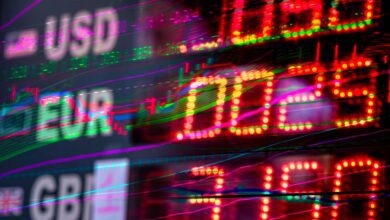Navigating the Forex Landscape: Interest Rates, Geopolitics, and Trading Strategies in a Changing Economy

In an increasingly interconnected global economy, the dynamics of currency exchange rates are influenced by a myriad of factors, ranging from interest rates to geopolitical events. As traders and investors seek to navigate the complexities of the foreign exchange (forex) market, a thorough understanding of these elements becomes essential. This article delves into the intricate relationship between interest rates and currency values, highlighting how fluctuations can impact trading strategies and market behavior. We will explore the powerful role of central banks in shaping monetary policy and currency valuation, as well as the influence of geopolitical shifts that can create volatility in forex markets. Additionally, we will examine the rise of digital currencies and their implications for traditional forex trading, alongside practical strategies for trading major currency pairs like EUR/USD and GBP/USD. By analyzing economic indicators and the concept of carry trading, we aim to provide insights that equip traders with the knowledge needed to make informed decisions in this ever-evolving landscape.
- 1. **Interest Rates and Currency Dynamics: Understanding the Connection**
- 2. **Geopolitical Shifts: The Unseen Hand in Forex Markets**
1. **Interest Rates and Currency Dynamics: Understanding the Connection**
Interest rates play a pivotal role in shaping currency dynamics and influence exchange rates through several mechanisms. When a country's central bank adjusts interest rates, it directly affects the return on investments denominated in that currency. Higher interest rates tend to attract foreign capital as investors seek better returns, subsequently increasing demand for that currency. This influx of capital can lead to an appreciation in the currency's value relative to others.
Conversely, when interest rates are lowered, the opposite effect can occur. Lower rates may deter foreign investment, leading to decreased demand for the currency and a potential depreciation. This relationship highlights the importance of interest rate differentials between countries. For example, if the European Central Bank raises rates while the Federal Reserve maintains lower rates, the euro may strengthen against the dollar as investors move funds into higher-yielding euro-denominated assets.
Moreover, interest rates also influence inflation expectations. Higher rates can help control inflation, which in turn supports a stronger currency. Conversely, if inflation rises unchecked, central banks may be pressured to raise rates, but if they fall behind the curve, it can lead to currency depreciation.
In summary, interest rates are a fundamental driver of currency dynamics, influencing investment flows, inflation expectations, and ultimately the value of currencies in the foreign exchange markets. Understanding these connections is crucial for traders and investors in predicting currency movements and making informed trading decisions.
Interest rates play a crucial role in determining currency exchange rates, as they influence both investor behavior and economic stability. When a country's central bank raises interest rates, it typically attracts foreign capital seeking higher returns, which increases demand for that country's currency and can lead to its appreciation. Conversely, falling interest rates may prompt capital outflows, resulting in currency depreciation.
Geopolitical events add another layer of complexity to forex markets. Political instability, trade disputes, or significant policy shifts can cause uncertainty, prompting investors to seek safe-haven currencies, such as the US dollar or Swiss franc. This reaction can lead to volatile fluctuations in currency values, as traders rapidly adjust their positions in response to news and events.
For traders focusing on major currency pairs like EUR/USD and GBP/USD, understanding the interplay between interest rates, geopolitical developments, and central bank policies is essential. These pairs are often influenced by the economic outlook of the Eurozone and the United Kingdom, with traders analyzing economic data releases, central bank announcements, and geopolitical tensions to inform their strategies.
Central banks are pivotal in shaping currency values through their monetary policy decisions. Tools such as interest rate adjustments, quantitative easing, and forward guidance can signal future economic conditions and influence market expectations. For instance, a central bank that is perceived as prioritizing inflation control may strengthen its currency, while one that is seen as accommodating to economic slowdowns may weaken it.
Inflation also significantly impacts forex trading strategies. Higher inflation in a country can erode purchasing power and lead to expectations of rising interest rates, potentially strengthening the currency in the short term. Traders often monitor economic indicators, such as Consumer Price Index (CPI) and Producer Price Index (PPI), to gauge inflation trends and adjust their strategies accordingly.
Carry trading is another strategy that capitalizes on interest rate differentials between currencies. Traders borrow in a currency with low interest rates and invest in a currency with higher rates, profiting from the difference. However, this strategy carries risks, especially in volatile markets where currency values can fluctuate rapidly, potentially erasing gains.
The rise of digital currencies is reshaping traditional forex markets as well. Cryptocurrencies, such as Bitcoin and Ethereum, have introduced new dynamics, attracting both retail and institutional investors. As digital currencies gain acceptance, their correlation with traditional fiat currencies may evolve, prompting forex traders to adapt their strategies to account for this emerging landscape.
Overall, understanding the multifaceted relationship between interest rates, geopolitical events, central bank actions, inflation, and the growing influence of digital currencies is vital for effective forex trading. By staying informed and analyzing economic indicators, traders can better predict currency movements and make informed trading decisions.
2. **Geopolitical Shifts: The Unseen Hand in Forex Markets**
Geopolitical shifts play a crucial and often unpredictable role in influencing forex markets. Events such as elections, conflicts, trade negotiations, and diplomatic relations can create volatility in currency values, affecting investor sentiment and market stability. For instance, a sudden political crisis in a major economy can lead to a rapid depreciation of its currency as investors flee to safer assets.
Furthermore, geopolitical tensions can alter trade relationships, resulting in shifts in demand for particular currencies. For example, if a country imposes tariffs on imports from another nation, the affected nation’s currency may weaken due to reduced trade flows and economic uncertainty. Conversely, a resolution to a geopolitical conflict or positive diplomatic developments can strengthen a nation's currency as confidence returns to the market.
Market participants often react quickly to news regarding geopolitical events, leading to fluctuations in exchange rates that can be both immediate and long-lasting. Traders must stay informed about global events and understand their potential implications for currency movements.
Additionally, central banks may adjust their monetary policies in response to geopolitical developments, further influencing forex markets. For example, if a country faces economic sanctions, its central bank may lower interest rates to stimulate growth, which can lead to a depreciation of its currency.
In summary, geopolitical shifts are a significant factor in the forex markets, as they can lead to sudden changes in currency values and trading strategies. Investors and traders must remain vigilant and adaptable in the face of these unpredictable influences to navigate the complexities of the forex landscape effectively.
In conclusion, the intricate relationship between interest rates and currency exchange rates is a vital consideration for traders and investors alike. As we have explored, changes in interest rates can lead to significant fluctuations in currency values, influencing trading strategies and investment decisions. Additionally, geopolitical events serve as a powerful catalyst in the forex markets, often leading to unpredictable shifts in currency pairs.
Central banks play a crucial role in this dynamic, with their policies directly impacting currency valuation and market sentiment. Furthermore, inflation remains a key factor, shaping trading strategies as market participants seek to anticipate future movements. The concept of carry trading highlights the potential for profit from interest rate differentials, while the emergence of digital currencies adds a new layer of complexity to traditional forex trading.
Ultimately, the effective use of economic indicators can guide traders in predicting currency movements, enabling them to navigate the volatile landscape of the forex market more successfully. By understanding these interconnected elements, traders can better position themselves to capitalize on opportunities and mitigate risks in an ever-changing economic environment.





